Good Cook, 2018. MDF covered in black library buckrum, images from Time-Life Book's The Good Cook, copper pots with salt and vinegar patina on chef's jacket and apron.
photo credit: Yuula Benevolski


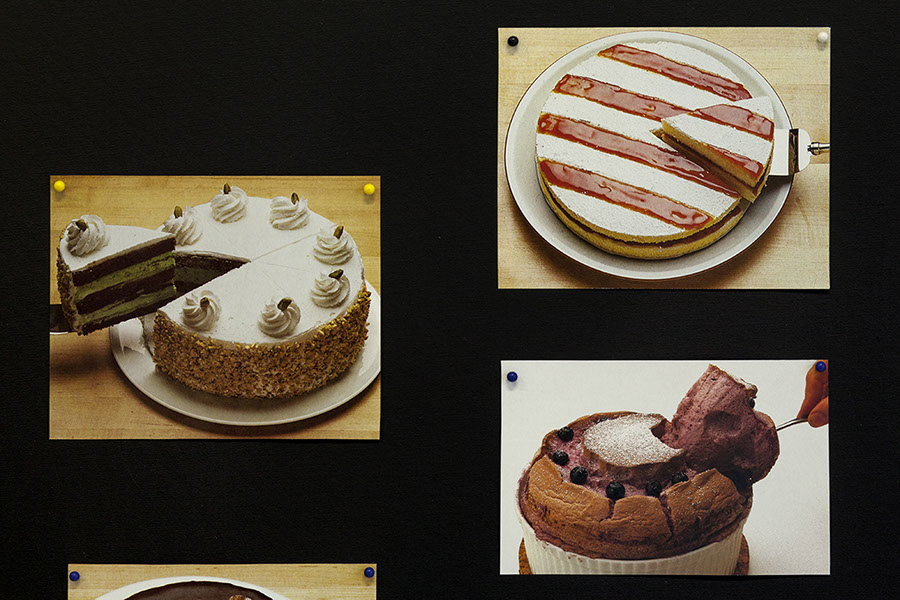






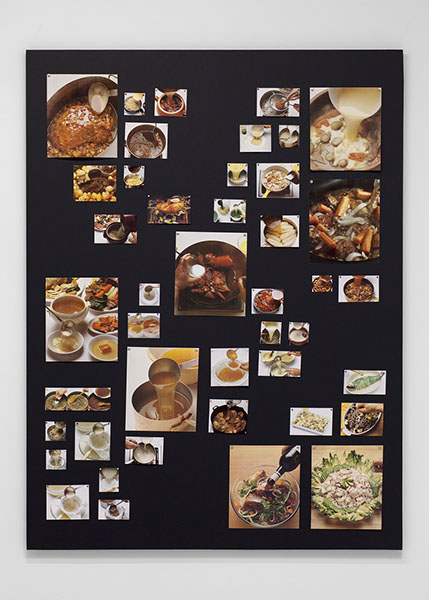


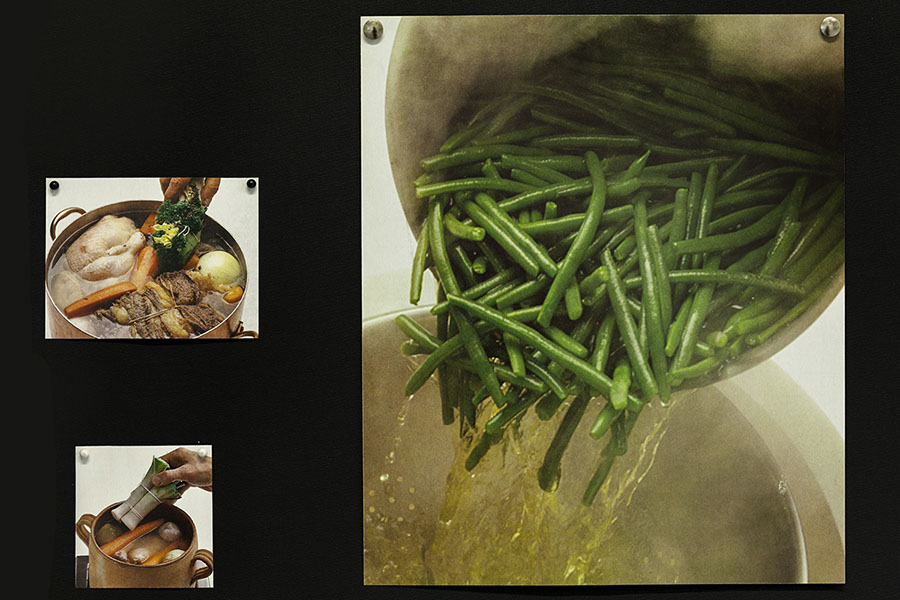
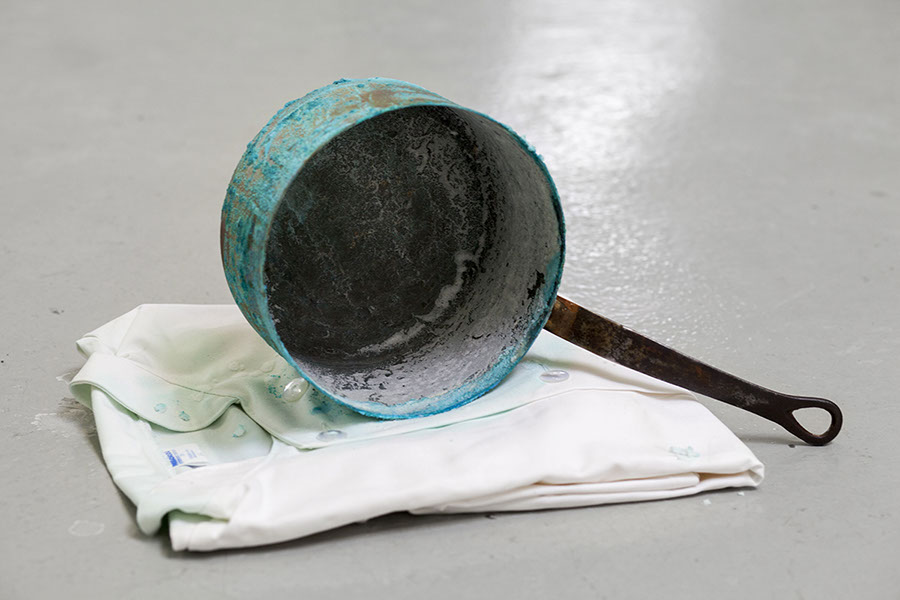
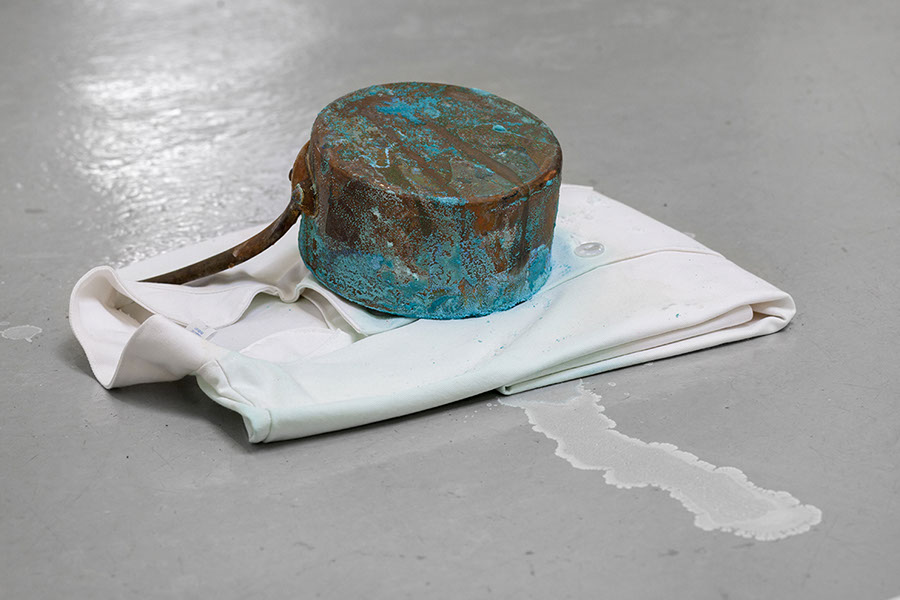




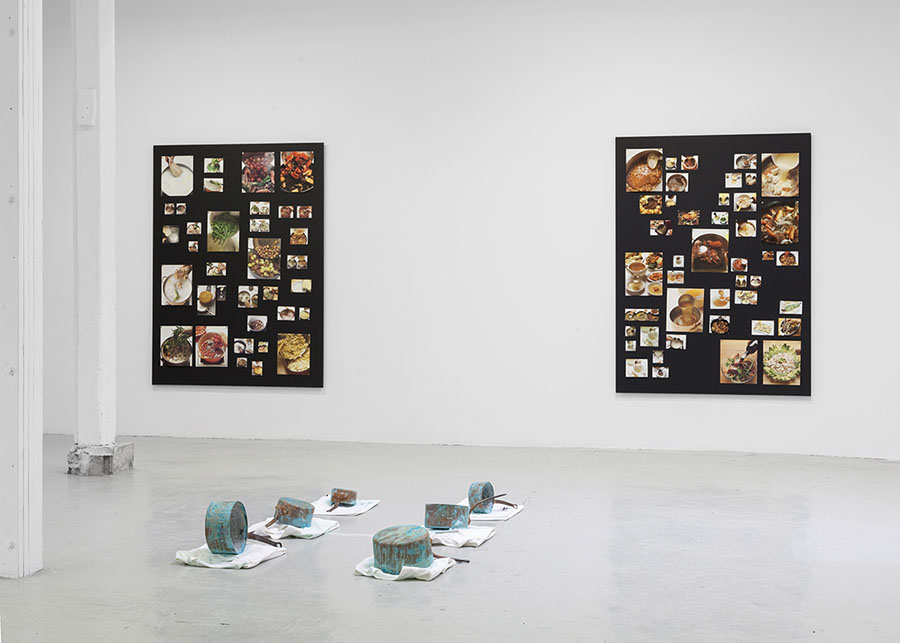
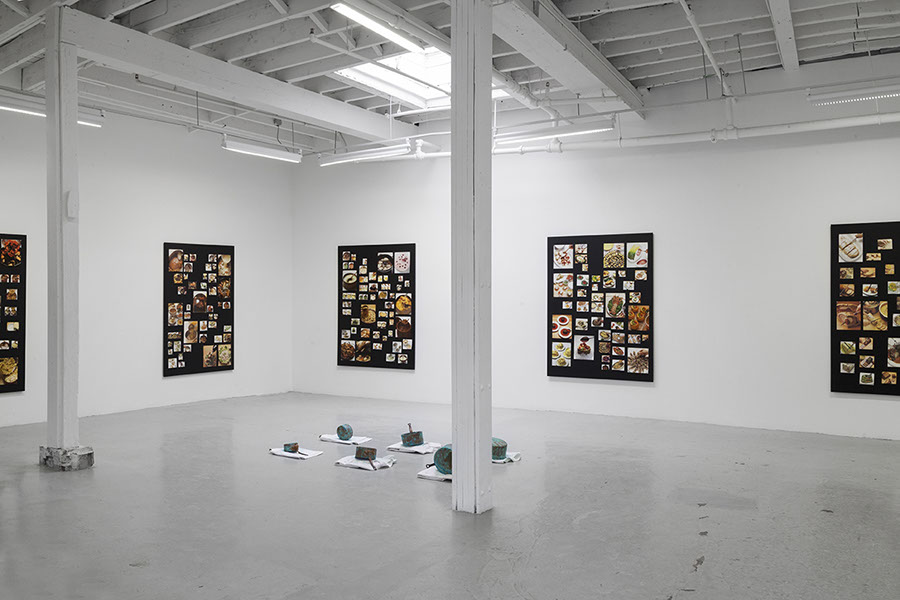
1. The imperfect librarian
In Jorge Luis Borges’ short story The Library of Babel (1941) the universe is conceived of as an immense library containing every book that has ever been written, that ever will be written, as well as those comprised of every possible ordering of the 25 characters (22 letters, the period, the comma, and the space) from which their writing is composed. The result is a library so expansive that it is altogether unnavigable, with the vast majority of its holdings being unintelligible gibberish — though the library also contains volumes that would make their translation possible. Borges then writes that the library is ‘unending,’ so it can be assumed that each book is repeated an infinite number of times all before being ordered upon the library’s shelves at random. Because of its scale, and lacking any comprehensible organizational structure, the library could just as usefully contain no books at all, as whatever true knowledge there is to be found, if it could be found, would be indistinguishable from that which is false.
Infidels claim that the rule in the Library is not “sense,” but “non-sense,” and that “rationality” (even humble, pure coherence) is an almost miraculous exception. They speak, I know, of “the feverish Library, whose random volumes constantly threaten to transmogrify into others, so that they affirm all things, deny all things, and confound and confuse all things, like some mad and hallucinating deity.”1
Although the library contains all knowledge, in fact because of it, it offers its readers little hope of locating a single fixed authority — should anyone still desire one. Proceeding then from the infidels’ description, within the library the exceptions of “sense" and “rationality” are at best contingent events, and even upon their appearance they remain hallucinatory abstractions that are easily untethered from intelligibility. Despite this, great care is taken to describe the books as physical, material objects; each is identical in format, four hundred ten pages in length, with each page containing forty lines of approximately eighty characters. However, within this feverish library the rigidity of a hardened cover does little to shield against transformation. Rather, its volumes remain both active and reactive, constantly transmogrifying to inarticulable ends, while leaving no material remainder as evidence of their re-mixture. In so much as these books and their contents do encounter one another, it is done through a sort of embodied bodilessness that allows them to synthesize new volumes from one another in order to “confound and confuse.”
Whatever knowledge is contained in Borges’ library, it is in excess of a material body, while also being intimately bound to one, even if that is ever-changing. Categorical segregation in such a vague library is then untenable, and the subtractive and axiomatized thinking that conventional organizational models are founded upon are here exploded — their debris scattered across an infinite universe from which something may (or may not) be reconstituted. If we are to use The Library of Babel as a most extreme example with which to think not only the material embodiment of an immaterial object (ie. a thought), but also the reorganization of knowledge systems toward more diffuse epistemological categories, what potentials might reside in such a dispersive gesture? And, although Borges’ library is engaging as a thought-experiment, how might this gesture be manifest as a material encounter back on Earth?
2. The law of the good neighbour
Fortunately it is not necessary to travel far before something resembling this ambition appears, as there are no lack of terrestrial libraries that in one way or another eschew traditional organizational strategies to unconventional ends — each usually accompanied by the tale of an eccentric founder or some bizarre history that has led them down this path to obscurity. The Kulturwissenschaftliche Bibliothek Warburg (KBW) offers itself as just such an example, now the centrepiece of the Warburg Institute at the University of London. It grew from what was at the turn of the 20th century the private library of art historian, bibliophile, and iconographer Aby Warburg (1866–1929), for which Warburg is known to have forfeited his right to a share of his family’s fortune on the condition that his younger brother buy him any books that he desired. The library is most notable for its peculiar system of arrangement, wherein books are not classified by subject, author, or title, but instead by what Warburg referred to as “the law of the good neighbour,” a model of organization that finds works arranged by their ability to engage with neighbouring volumes. A line of thought or inquiry opened in one was, “attested to or attacked, continued or contradicted, refined of refuted in its neighbour. Each book was to answer or ask a question of the one next to it.”2
The library’s current collection continues to reflect the interests expressed by Warburg as a young researcher, encompassing such varied categories as art history, astrology, magic, medicine, science, symbolism, and myriad others, with particular attention devoted to how these were manifest throughout the Italian Renaissance. Many of these interests were developed through the serendipity of collecting, where a proximal relation between disparate sources would open new avenues of interest requiring further investigation and further collecting. This methodology is most clearly exhibited in Warburg’s unfinished Atlas Mnemosyne project, which gathered together and arranged over 1000 black and white images of art historical and cosmological images, supplemented by photographs of maps, manuscript pages, as well as contemporary images sourced from newspapers and advertisements. Organized across 40 panels, Warburg grouped the images by their gestural commonalities producing specific gestural histories spanning thousands of years. Through these panels, what is exposed is not a series of rigid immovable images, but instead what Warburg described as “bewgetes Leben” (life in motion), the re-animated transformation of gestures from antiquity to the early 20th century in Western Europe. Though with Warburg’s library and Mnemosyne project we see the beginning of processes of mixing and blending, its purview remains limited to the particular interests of its founder and those that later assumed its Directorship. These often abandoned the transmodal potentials immanent to such synthetic operations, veering instead toward a hermetic academicism and fetishization of books-as-objects, but as a study it remains compelling as an experimental model for the type of categorical untethering that can be thought through The Library of Babel.
While the library remains focused on the investigations originally identified in Warburg’s own iconographic research, it has in the years since it moved to London grown in unexpected ways as sympathetic practitioners, often outside of academia, have donated their own eccentric collections. In 1992 the private library of the British cookery writer Elizabeth David joined the Warburg’s collection providing another serendipitous intervention as it offers here an exit from the library toward a site that might yield a more dynamic line of inquiry: the kitchen. A very good neighbour, indeed.
3. Culinary chemistry
David is best remembered for the significant role she played in revitalizing the art of home cookery in the UK through the series of articles and books she authored on European cuisines and traditional British dishes in the post-war period. Like Warburg, David's research privileged Mediterranean traditions, and her first collection of recipes was simply titled A Book of Mediterranean Food. It is then possible that the affinity she felt for Warburg's library was simply based on geography, but it may also be productive to consider the possibility that she had come to recognize that the operations of mixing and blending belonging to her own kitchen shared a synthetic ambition with Warburg’s iconography. Ultimately, the inclusion of David’s collection within a university's research library attests to the seriousness accorded her project, which she viewed as not only culturally significant, but also as scholarly in nature and worthy of preserving as such.
With its’ donation to the Warburg Institute, what prompt might then be provided by the library of a mid-century ‘celebrity chef’ in rethinking the organization of systems of knowledge toward more diffuse ends? In the seventh volume of the philosophical research journal Collapse, editors Reza Negarestani and Robin Mackay gather together a collection of far-reaching sources to propose new models for thinking through a culinary lens, asking, “How might the everyday, restricted sense of the culinary be expanded into a culinary materialism wherein synthesis, experimentation, and operations of mixing and blending take precedence over analysis, subtraction and axiomatization?”3 The journal draws from an array fields, positioning the research of anthropologists, chemists, contemporary artists, mathematicians, and military historians alongside one another to synthesize a model for philosophical thought that extends beyond categorical definition into the realm of experimental conceptual production.
In an interview between Collapse and philosopher Iain Grant Hamilton, he describes this culinary model for thought as chemical in nature. Hamilton argues that while the history of chemistry as a discrete scientific discipline is often thought as beginning when it became disentangled from artisanal traditions and alchemy, to understand the potentials of chemistry as an operational model for conceptual production one need not look beyond its earliest practical applications that sought to understand the elemental composition of matter; the blacksmith’s forge; the potter’s wheel; the perfumer’s salon … all proceeded by the kitchen. Referencing a history of chemical investigations, especially from the age of ‘natural philosophy,’ he describes these as providing an additional visceral dimension to the empirical materiality present in other natural sciences, which is arrived at in chemistry through a sort of "messy experimentation.” Further, in terms of a model for thought, chemistry proposes that while analysis remains an important part of understanding nature, this is incomplete until synthesis takes place, or, “it's not just about understanding the 'nature of nature', not just about metaphysics - it’s about recreating nature.”4 To this end we might imagine a paradigm of chemical thinking extended to other disciplines that produces a comparable synthetic investigation. This reciprocal relation between analysis and synthesis might then be used to formulate new models of knowledge organization, which rather than classifications and categorizations based upon given terms of structural invariance, reveal the generative potentials of a synthetic procedure.
David’s donation might then be useful in providing a necessary precedent for the naming of ‘synthesis’ as the central operation occurring in Warburg’s project — and in Borges’ library — whether this be chemical in nature or otherwise. Its’ inclusion here can then be thought of as an emulsifier; stabilizing otherwise immiscible thoughts just long enough that new ones might emerge — a chemical operation present in both Warburg and Borges, but belonging first to the kitchen.
4. The Good Cook
This onion will become a motion
this grapefruit
will become a thought. 5
Titled after a series of instructional cookbooks produced by Time-Life in the early 1980s, Good Cook proposes the reorganization of existing knowledge categories by looking to the culinary as an operational model founded upon mixing and blending. Considering the kitchen as a plastic site where experimentation and synthesis take precedence over axiomatization and analysis, the exhibition positions chemistry’s “messy experimentation” as a model for this reformulation, where formerly localized categories might be blended and mixed to produce new compound expressions. The exhibition considers the generic cookbook as an especially reactive type of reference, further extended in its responsiveness through the exhibition’s quotation of Aby Warburg’s iconographic methodology as it appears in his Atlas Mnemosyne project.
Each of the 28 volumes in Time-Life Books’ The Good Cook is dedicated to a specific culinary category (Eggs & Cheese, Pasta, Sauces, Vegetables, etc …), attempting to instruct home cooks in the techniques of ‘renowned chefs and gourmands’ as selected by its editor Richard Olney. 6 Like other best-selling Time-Life series of the period (Enchanted World, Mysteries of the Unknown, The Seafarers) The Good Cook positioned itself as a singular encyclopedic reference, constructing a false horizon within the culinary through the editors’ regional preferences, and recommitting the copyist’s error of conjoining enkyklios (general) with paideia (education) to produce an incomplete enkyklopaidia (complete knowledge). Like Warburg’s library The Good Cook compendium is restricted by these limitations, betraying the synthetic potentials immanent to its contents.
Rather than claiming to re-present an incomplete “life in motion” a la Warburg, the panels that comprise Good Cook only untether these existing images from their binding, proposing the potential of a synthetic thought where experimentation and operations of mixing and blending take precedence over analysis, subtraction and axiomatization.
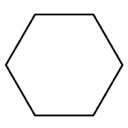
1. Borges, J. (1941) “The Library of Babel" The Garden of Forking Paths. Trans. Andrew Hurley. NewYork, NY: Penguin
2. Durantaye, L. (2009): Giorgio Agamben: A Critical Introduction. Stanford (CA): Stanford University Press.
3. Mackay, R./Negarestani, R. (eds.) (2011): Collapse VII: Culinary Materialism. Falmouth.
4. Hamilton, Iain Grant (2011): “The Chemical Paradigm (Interview)” Collapse VII: Culinary Materialism. Falmouth.
5. Atwood, M. (1976): Selected poems: 1965-1975. Boston (Mass.): Houghton Mifflin.
6. Many of the recipes featured in The Good Cook first appeared in the culinary journal Petits Propos Culinaires, which was conceived of in 1979 alongside Elizabeth David and Alan and Jane Davidson while Olney was preparing for his Time-Life project.